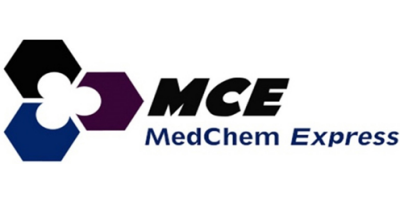

- Home
- Companies
- MedChemExpress LLC (MCE)
- Products
- MedChemExpress - Model Telomerase-IN-1 ...
MedChemExpress - Model Telomerase-IN-1 - 666859-49-0
Telomerase-IN-1 is a Telomerase inhibitor with an IC50 of 0.19 μM.MCE products for research use only. We do not sell to patients.
Telomerase-IN-1
MCE China:Telomerase-IN-1
Brand:MedChemExpress (MCE)
Cat. No.HY-U00268
CAS:666859-49-0
Purity:99.84%
Storage:4°C, sealed storage, away from moisture and light *In solvent : -80°C, 6 months; -20°C, 1 month (sealed storage, away from moisture and light)
Shipping:Room temperature in continental US; may vary elsewhere.
Description:Telomerase-IN-1 is a Telomerase inhibitor with an IC50 of 0.19 μM.
In Vitro:Our in vitro studies show that title compound (Telomerase-IN-1) has high inhibitory activity against telomerase and high antiproliferative capacity on SMMC-7721 cells, and has no obvious toxic effect on human normal hepatocyte cells. Telomerase-IN-1 treatment decreases the growth of cancer cells in dose- and time-dependent manners; however, the viability of L-02 shows slight changes in the compound at 10 μM. 48 h of SMMC-7721 cell treatment with the Telomerase-IN-1 (20, 40, and 80 nM) causes increase of apoptosis. Forty-eight hours of SMMC-7721 cell treatment with the Telomerase-IN-1(20, 40, and 80 nM) causes significant accumulation of green fluorescence, indicating a decrease in MMP. At 40 nM, Telomerase-IN-1 significantly increases expressions of cyt-c and Bax, but the Bcl-2 level is decreased[1].
In Vivo:Our in vivo studies show that this compound (Telomerase-IN-1) significantly inhibits tumor growth in xenograft tumor models. Results show that endoplasmic reticulum stress (ERS) through ER over response (EOR) activates the expression of hTERT, and then induces ERS, which is believed to be intricately associated with oxidative stress and mitochondrial dysfunction, resulting in apoptotic cell death, thereby modulating the expression of downstream signaling molecules including CHOP (CAAT/enhancer-binding protein homologous protein)) and mitochondrion pathway of apoptosis, leading to inhibition of cell proliferation[1].
Animal Administration:To test whether the Telomerase-IN-1 shows any antitumor effect in vivo, SMMC-7721 cells are xenografted into nude mice, and then the tumor-bearing animals are treated with the Telomerase-IN-1 (25, 50, and 100 μM/daily) for 37 days by intraperitoneal injection[1].
Cell Assay:The effect of the title compound (Telomerase-IN-1) on the viability of human hepatoma cancer cell (SMMC-7721) is examined by increasing concentrations (3.2, 16, 80, 400, and 2000 nM). A normal liver cell line (L-02) is used as control. Cell viability is measured by MTTassay at 48 h[1].
IC50 & Target:IC50: 0.19 μM (Telomerase) [1] In Vitro Our in vitro studies show that title compound (Telomerase-IN-1) has high inhibitory activity against telomerase and high antiproliferative capacity on SMMC-7721 cells, and has no obvious toxic effect on human normal hepatocyte cells. Telomerase-IN-1 treatment decreases the growth of cancer cells in dose- and time-dependent manners; however, the viability of L-02 shows slight changes in the compound at 10 μM. 48 h of SMMC-7721 cell treatment with the Telomerase-IN-1 (20, 40, and 80 nM) causes increase of apoptosis. Forty-eight hours of SMMC-7721 cell treatment with the Telomerase-IN-1(20, 40, and 80 nM) causes significant accumulation of green fluorescence, indicating a decrease in MMP. At 40 nM, Telomerase-IN-1 significantly increases expressions of cyt-c and Bax, but the Bcl-2 level is decreased[1]. MedChemExpress (MCE) has not independently confirmed the accuracy of these methods. They are for reference only. 0 --> Telomerase-IN-1 Related Antibodies
Hot selling product:Flavopiridol (Hydrochloride) | Lamivudine | GLP-1(7-37) | Erdafitinib | Pyridostatin (hydrochloride) | Abaloparatide (TFA) | NG 52 | Blinatumomab | Papain | Acetylcholine (chloride)
Trending products:Recombinant Proteins | Bioactive Screening Libraries | Natural Products | Fluorescent Dye | PROTAC | Isotope-Labeled Compounds | Oligonucleotides
References:
[1]. Cheng X, et al. Discovery of (4-bromophenyl)(3-hydroxy-4-methoxyphenyl)methanone through upregulating hTERT induces cell apoptosis and ERS. Cell Death Dis. 2017 Aug 24;8(8):e3016. [Content Brief]
Brand introduction:
• MCE (MedChemExpress) has a global exclusive compound library of more than 200 kinds, and we are committed to providing the most comprehensive range of high-quality small molecule active compounds for scientific research customers around the world;
• More than 50,000 highly selective inhibitors and agonists are involved in various popular signaling pathways and disease areas;
• The products cover a variety of recombinant proteins, peptides, commonly used kits, more PROTAC, ADC and other characteristic products, widely used in new drug research and development, life science and other scientific research projects;
• Provide virtual screening, ion channel screening, metabolomics analysis detection analysis, drug screening and other professional technical services;
• It has a professional experimental center and strict quality control and verification system;
• Provide LC/MS, NMR, HPLC, chiral analysis, elemental analysis and other quality inspection reports to ensure the high purity and high quality of products;
• The biological activity of the products has been verified by the experiments of customers in various countries;
• A variety of top journals such as Nature, Cell, Science and pharmaceutical patents have included the scientific research results of MCE customers;
• Our professional team tracks the latest pharmaceutical and life science research and provides you with the latest active compounds in the world;
• It has established long-term cooperation with the world's major pharmaceutical companies and well-known scientific research institutions。
